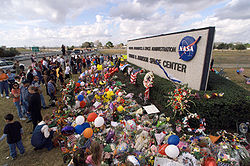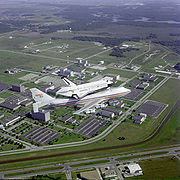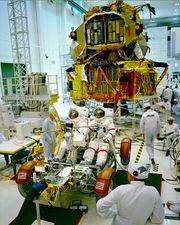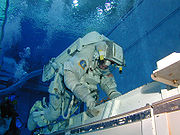Lyndon B. Johnson Space Center
| Lyndon B. Johnson Space Center | |
|---|---|
 |
|
 |
|
| Aerial view of JSC in 1989 | |
| Agency overview | |
| Formed | September 1963 |
| Preceding agency | Manned Spacecraft Center |
| Jurisdiction | U.S. federal government |
| Headquarters | Houston (Texas, USA) |
| Employees | 3,200 civil service |
| Agency executive | Mike Coats, director |
| Parent agency | NASA |
| Website | |
| JSC home page | |
The Lyndon B. Johnson Space Center (JSC) is the National Aeronautics and Space Administration's center for human spaceflight training, research and flight control. The center consists of a complex of 100 buildings constructed on 1,620 acres (656 ha) in Houston, Texas.[1] Johnson Space Center is home to the United States astronaut corps and is responsible for training astronauts from both the U.S. and its international partners. It is often popularly referred to by its central function, "Mission Control".
The center, originally known as the Manned Spacecraft Center, was constructed on land donated by Rice University and opened in 1963. On February 19, 1973, the center was renamed in honor of the late U.S. president and Texas native, Lyndon B. Johnson.[2] JSC is one of ten major NASA field centers.
Contents |
History


Johnson Space Center has its origins in legislation shepherded to enactment in 1958 by then-U.S. Senator Lyndon Johnson. After President John F. Kennedy made the goal in 1961 to put a man on the Moon by the end of the decade, the Space Task Group was formed with Langley Research Center engineers to lead the Apollo Project.[3] The group would need test facilities and research laboratories suitable to mount an expedition to the moon. In July 1961, NASA Administrator James E. Webb headed the site selection team. Requirements for the new site included the availability of water transport and an all-weather airport, proximity to a major telecommunications network, availability of established industrial workers and contractor support, an available supply of water, a mild climate permitting year-round outdoor work and a culturally attractive community. Houston was initially included because of the proximity to the 4,700-acre (19 km2) United States Army San Jacinto Ordnance Depot located on the Houston Ship Channel, and to regional universities, including Rice University, University of Texas, and Texas A&M University.[3] The selection of Houston for the site was announced in September 1961. The land for the new facility was donated by Rice University and was situated in an undeveloped area 25 miles (40 km) southeast of Houston near Galveston Bay.[4][5] Construction of the center, designed by Charles Luckman, began in April 1962, and the facility was officially opened for business in September 1963.[6][7] When opened, the 1,620-acre (660 ha) facility was originally designated the Manned Spacecraft Center (MSC) and was to be the primary center for U.S. space missions involving astronauts.[4][5]
The center's Mission Control Center has been the operational center of every American human space mission since Gemini IV. The control center manages all activity on board the spacecraft and directs all space shuttle missions. Mission Control Center was constructed in 1962.[3] By 1965, JSC was fully operational and has been responsible for coordinating and monitoring every crewed NASA mission since the Gemini Project.
In addition to housing NASA's astronaut operations, JSC is also the site of the former Lunar Receiving Laboratory, where the first astronauts returning from the moon were quarantined, and where the majority of lunar samples are stored. The center's Landing and Recovery Division operated MV Retriever in the Gulf of Mexico for Gemini and Apollo astronauts to practice water egress after splashdown.
In the wake of the January 28th, 1986 Space Shuttle Challenger disaster, then-President Ronald Reagan and First Lady Nancy traveled to JSC on January 31 to speak at a memorial service honoring the astronauts. It was attended by 6,000 NASA employees and 4,000 guests, as well as by the families of the crew. During the ceremony, an Air Force band led the singing of "God Bless America" as NASA T-38 Talon supersonic jets flew directly over the scene, in the traditional missing-man formation. All activities were broadcast live by the national television and radio networks.
One of the artifacts displayed at Johnson Space Center is the Saturn V rocket. It is whole, except for the ring between the S-IC and S-II stages, and the fairing between the S-II and S-IVB stages, and made of actual surplus flight-ready articles. It also has a real (though incomplete) Apollo CSM, intended to fly in the canceled Apollo 19 mission.
In September 2008, NASA's Johnson Space Center celebrated its 50th year of leading America into space.[8]
On April 20, 2007 a hostage situation developed in Building 44, the Communication and Tracking Development Laboratory where a gunman killed one person, injured another, and took a hostage for over three hours until finally committing suicide.
On September 13, 2008 Hurricane Ike hit Galveston as a Category 3 Hurricane and caused minor damage to the Mission Control center and other buildings in the Johnson Space Center.[9] The storm damaged the roofs of several hangars for the T-38 Talons at Ellington Field.[9]
Facilities
The Johnson Space Center is home to Mission Control Center (MCC-H), the NASA control center that coordinates and monitors all human spaceflight for the United States. MCC-H directs all Space Shuttle missions and activities aboard the International Space Station. The Apollo Mission Control Center, a National Historic Landmark can be found in building 30. From the moment a spacecraft clears its launch tower until it lands back on earth, it is in the hands of Mission Control. The Mission Control Center houses several Flight Control Rooms, from which Flight controllers coordinate and monitor the spaceflights. The rooms have many computer resources to monitor, command and communicate with spacecraft. When a mission is underway the rooms are staffed around the clock, usually in 3 shifts.
The center handles most of the planning and training of the US astronaut corps and houses training facilities such as the Sonny Carter Training Facility and the Neutral Buoyancy Laboratory, which is a critical component in the training of astronauts for spacewalks. The Neutral Buoyancy Laboratory provides a controlled neutral buoyancy environment a very large pool containing about 6.2 million US gallons (23,000 m³) of water where astronauts train to practice extra-vehicular activity tasks while attempting to simulate zero-g conditions.[10][11] The facility provides pre-flight training in becoming familiar with crew activities and with the dynamics of body motion under weightless conditions.[12]
The center is also responsible for direction of operations at White Sands Test Facility in New Mexico, which serves as a backup Shuttle landing site and would be the coordinating facility for the Constellation program, which was planned to replace the Space Shuttle program after 2010.[1]
The visitor's center of Johnson Space Center is Space Center Houston since 1994. One of the JSC buildings (Building 2) once housed the JSC Visitor's Center.
The Johnson Space Center Heliport (FAA LID: 72TX) is located on the campus. Ronald C. Bailey manages the heliport.[13]
 Mission Control Center. |
 Space Shuttle Challenger, atop its Boeing 747 SCA, flying over JSC. |
Astronaut photograph centred on the JSC. |
Personnel and training


Approximately 3,200 civil servants, including 110 astronauts, are employed at Johnson Space Center. The bulk of the workforce are the over 15,000 contractors. Over 15 contracting firms work at JSC; the largest is the United Space Alliance, which accounts for about 40 percent of the JSC employees. As of November 2005 the center's tenth director is former astronaut Michael Coats, the first being Robert Gilruth.
NASA's astronaut training is conducted at the Johnson Space Center. Astronaut candidates receive training on shuttle systems and in the basic sciences which include mathematics, guidance and navigation, oceanography, orbital dynamics, astronomy, and physics.[12] Candidates are required to complete military water survival prior to beginning their flying instruction. Candidates are also required to become SCUBA qualified for extravehicular training and are required to pass a swimming test.[14][15] EVA training is conducted at the Sonny Carter Training Facility. Candidates are also trained to deal with emergencies associated with hyperbaric and hypobaric atmospheric pressures and are given exposure to the microgravity of space flight.[12] Candidates maintain their flying proficiency by flying 15 hours per month in NASA's fleet of T-38 jets based at nearby Ellington Field. Additionally, candidates practice Orbiter landings in the Shuttle Training Aircraft.[12]
The astronauts begin their formal training program during their year of candidate training by reading manuals and by taking computer-based training lessons on the various Orbiter systems. The training process includes practice with the single systems trainer where the astronauts are trained to operate each Orbiter system and to recognize malfunctions and perform corrective actions.
Following SST training, the astronauts begin training in the Shuttle Mission Simulators (SMSs). The SMS provides training of shuttle vehicle operations and systems tasks associated with the major flight phases. Astronauts begin their training in the SMS using training software until they are assigned to a particular mission. Astronauts also train with the flight controllers in the Mission Control Center. The SMS and MCC are linked by computer in the same way the Orbiter and MCC are linked during an actual mission.
Research
Johnson Space Center leads NASA’s flight-related scientific and medical research programs. Technologies developed for spaceflight are now in use in many areas of medicine, energy, transportation, agriculture, communications and electronics.[16]
The Astromaterials Research and Exploration Science (ARES) office performs the physical science research at the center. ARES directs and manages all functions and activities of the ARES scientists that perform basic research in earth, planetary, and space sciences. ARES scientists and engineers provide support to the human and robotic spaceflight programs. The responsibilities of ARES also include interaction with the Office of Safety and Mission Assurance and the Human Space Flight Programs.[17]
Johnson Space Center was granted a five-year, $120-million extension of its agreement with the National Space Biomedical Research Institute at Baylor College of Medicine to study the health risks related to long-duration space flight. The extension will allow a continuation of biomedical research in support of a long-term human presence in space started by the institute and NASA's Human Research Program through 2012.[18]
The Prebreathe Reduction Program is a research study program at the JSC that is currently being developed to improve the safety and efficiency of space walks from the ISS.[19]
The Overset Grid-Flow software was developed at Johnson Space Center in collaboration with NASA Ames Research Center. The software simulates fluid flow around solid bodies using computational fluid dynamics.
See also
- Clear Lake Area
- Mission Control Center
- Neutral Buoyancy Laboratory
- Ellington Field
- List of NASA contractors
- Robert R. Gilruth
References
- ↑ 1.0 1.1 NASA. "Lyndon B. Johnson Space Center". http://www.sti.nasa.gov/tto/spinoff1997/ar5.html. Retrieved 2008-08-27.
- ↑ "Houston Space Center Is Named for Johnson". New York Time. February 20, 1973. p. 19.
- ↑ 3.0 3.1 3.2 "JSC History". http://www.jsc.nasa.gov/history/jsc_history.htm. Retrieved 2008-03-25.
- ↑ 4.0 4.1 Schulman, Bruce J. (1994). From Cotton Belt to Sunbelt: Federal Policy, Economic Development, and the Transformation of the South 1938-1980. Duke University Press. p. 149. ISBN 978-0-8223-1537-7. http://books.google.com/?id=vwcGbPRuM9oC.
- ↑ 5.0 5.1 "TOWING TRACTORS...: LYNDON B. JOHNSON SPACE CENTER". NASA: Kennedy Space Center. http://science.ksc.nasa.gov/shuttle/technology/sts-newsref/sts-jsc.html. Retrieved 19 Jan 2010.
- ↑ "Charles Luckman Biography". 1 LMU Drive, MS 8200, Los Angeles, CA 90045: Loyola Marymount University. 2007. http://www.lmu.edu/Page42430.aspx. Retrieved July 6, 2009.
- ↑ "Lyndon B. Johnson Space Center". NASAFacts. JSC 04264 Rev D.
- ↑ "JSC Celebrates 40 Years of Human Space Flight". National Aeronautics and Space Administration. http://www.nasa.gov/centers/johnson/about/history/jsc40/jsc40_pg1.html. Retrieved 2007-02-18.
- ↑ 9.0 9.1 Frank Morring, Jr. (2008-09-16). "Ike Damage To NASA-JSC Light". Aviation Week. http://www.aviationweek.com/aw/generic/story.jsp?id=news/Hurri091608.xml&headline=Ike%20Damage%20To%20NASA-JSC%20Light%20&channel=space. Retrieved 2009-10-18.
- ↑ Strauss S (July 2008). "Space medicine at the NASA-JSC, neutral buoyancy laboratory". Aviat Space Environ Med 79 (7): 732–3. PMID 18619137.
- ↑ Strauss S, Krog RL, Feiveson AH (May 2005). "Extravehicular mobility unit training and astronaut injuries". Aviat Space Environ Med 76 (5): 469–74. PMID 15892545. http://www.ingentaconnect.com/content/asma/asem/2005/00000076/00000005/art00008. Retrieved 2008-08-27.
- ↑ 12.0 12.1 12.2 12.3 NASA. "Astronaut Selection and Training". http://spaceflight.nasa.gov/shuttle/reference/factsheets/asseltrn.html. Retrieved 2008-08-27.
- ↑ http://www.airnav.com/airport/72TX
- ↑ Fitzpatrick DT, Conkin J (2003). "Improved pulmonary function in working divers breathing nitrox at shallow depths". Undersea Hyperb Med abstract 30 (Supplement). http://archive.rubicon-foundation.org/1273. Retrieved 2008-08-27.
- ↑ Fitzpatrick DT, Conkin J (July 2003). "Improved pulmonary function in working divers breathing nitrox at shallow depths". Aviat Space Environ Med 74 (7): 763–7. PMID 12862332. http://www.ingentaconnect.com/content/asma/asem/2003/00000074/00000007/art00011. Retrieved 2008-08-27.
- ↑ NASA (PDF). Johnson Space Center: Exploring the science of space for the future of Earth. NASA. http://www.nasa.gov/centers/johnson/pdf/167745main_FS_JSC508c.pdf. Retrieved 2008-08-27.
- ↑ "Astromaterials Research Office". Johnson Space Center. http://ares.jsc.nasa.gov/kr.cfm. Retrieved 2009-10-18.
- ↑ "Johnson Space Center to continue biomedical research". Houston Business Journal. http://houston.bizjournals.com/houston/stories/2007/10/01/daily20.html. Retrieved 2009-10-18.
- ↑ "Comparison of V-4 and V-5 Exercise/Oxygen Prebreathe Protocols to Support Extravehicular Activity in Microgravity". NASA Technical Reports. http://ntrs.nasa.gov/search.jsp?R=1020700&id=7&as=false&or=false&qs=No%3D40%26Ns%3DHarvestDate%257c1%26N%3D4294888873. Retrieved 2009-10-18.
External links
- Lyndon B. Johnson Space Center
- Suddenly, tomorrow came... A history of the Johnson Space Center (PDF format) 1993
- Roundup, official newsletter
- NASA Johnson Space Center Oral History Project - Interview with Thomas W. 'Tommy' Holloway
- "America's Space Program: Exploring a New Frontier", a National Park Service Teaching with Historic Places (TwHP) lesson plan
- Aviation: From Sand Dunes to Sonic Booms, a National Park Service Discover Our Shared Heritage Travel Itinerary
- Mission Control Archive Footage
|
|||||||||||